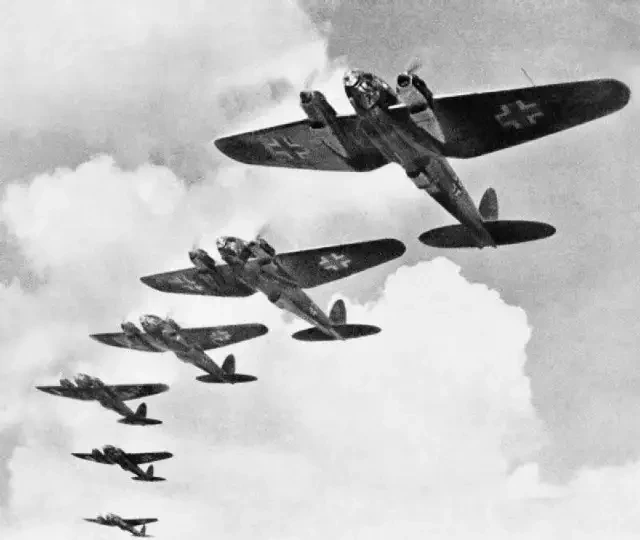This year (2021) is the 81th anniversary of the Battle of Britain. On 15th September 1940, The Battle of Britain Day was officially named by Royal Air Force because they claimed it was a victory over the Luffwaffe (German Air Force). It was the first fight majorly fought by air forces, and the biggest aerial bombing campaign. The victory of the UK can result from the fights of Royal Air Forces and the highly effective air defensive network.
Royal Air Force prevented German from invading The United Kingdom. In 1940, Allied and French forces got beat by German Forces. After allied troops has retreated from Dunkrik, Adolf Hitler has made a plan called Unternehem Seelowe in order to invade Great Britain. At first, Luffwaffe delivered many bombers such as Junkers Ju-88, Henkiel He-111, Donier Do-17 to France. Since bombers took off from bases which were closed to Strait of Dover, the mainly raiding targets of Luffwaffe were London and other coastal cities. Though Luffwaffe conducted a lot of air raids against British industrial targets for several months, the British didn’t surrender, especially those fighters — Royal Air Force pilots of Supermarine Spitfire and Hawker Hurricane. Because over a year, Luffwaffe could not gain the air superiority, Führer was forced to canceled his operation of landing on Great Britain.
owever, not only the RAF pilots but also people of the so called Dowding system contributed to the victory of the Battle of Britain. “The battle of France is over, I expected the Battle of Britain is about to begin.” Winston Churchill said in June 18, 1940. Before German started to attack the UK, the British had done many defensive measures for the war by creating home guards and building coast crusts. What’s more, the British brought radars and fighters into a unified defensive system. Hence, there were many causes of the winning of the battle.
One of the main cause of victory was RAF pilots and their fighters. In 1940, Messerschmitt Bf-109 was the backbone of Luffwaffe. It was a fast, single-seat fighter. The E variants, which equipped with two MGFF20mm cannons and two 7.7mm machine guns, were the most advanced aircraft in Europe sky. In contrast, RAF was on the way of fastening the production of newly counterparts of Bf-109, the Supermarine Spitfire Mk.I because most of RAF squadrons were equipped slow, but reliable Hawker Hurricanes. Though British fighters were outnumbered by Luffwaffe, they didn’t give up any chance and keep intercepting German bombers. Pilots from Ukraine, French, Canada and Poland joined the battle, fly with British pilots for they were in the same boats with The British, even though some of them couldn’t speak English.
Another cause of the lost of Luffwaffe was their bad strategies. Bf-109 could escort bombers to London, but its flight length was rather short, that is, fighters could only dogfight with British fighters for 10 minutes. After that fighters must retreat quickly or they would fall into the sea and pilots would be captured by the British. What’s more, although twin-engined heavy fighter Bf-110s were able to escort bombers, they could not dogfight with Spitfires. Thus, without cover from fighters, bombers became lambs to be slaughtered by the British fighters. Because He-111s only had small caliber defensive machine guns, while the Spitfires were equipped with 2 times of machine guns (8x 7.7mm Vickers) and 4 times for the Hurricanes (12x 7.7mm Vickers) As a result of short flight range of escort fighters, more and more bombers were easily got shot down, mostly by Hawker Hurricanes.
The most important cause was British’s radar system. Before World War II, RAF had built many early warning radar stations near the costal. Chain home, the code name of these stations, can track and detect aircraft. Therefore, when German bombers were getting close to the UK, commanding office located at London would start processing datas from the radar stations and predicted the flying routes of the enemies, then called nearest squadrons to intercept them. A squadron had at least sixteen fighters and been spilt into two Flights. A Flight had two section and three aircraft for each. Thus, fighters would fly in Vic formation, attack from bombers’ rear high six in order to break bombers formation. The more maneuverable Spitfire would engage with Bf-110s and Bf-109s thereby giving slow Hurricanes with powerful machine guns chances to kill bombers.
In conclusion, air defensive networks and efforts of RAF people leads to the victory of the battle. First, people around the world helped the British fight against Nazi Germany. Second, German didn’t prepare well for invading the UK. Third, radars played an important role in tasks of intercepting bombers. The Battle of Britain was one of the significant turn points of World War II, and the first big victory for Allied forces. As a wartime speech delivered by Winston Churchill
“Never was so much owed by so many to so few”.